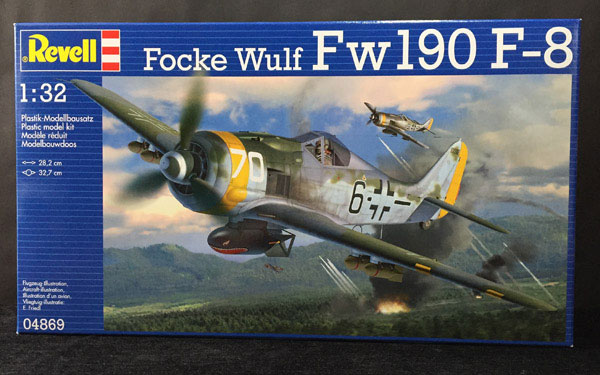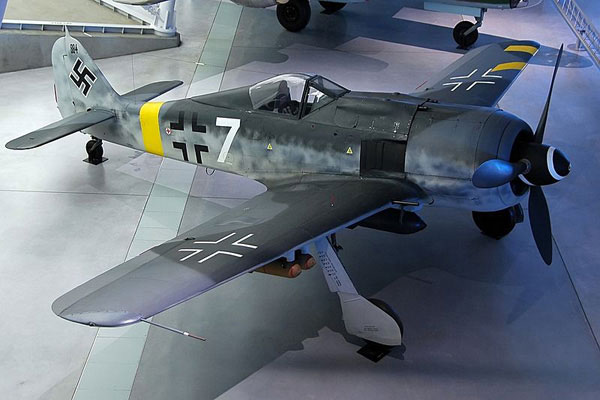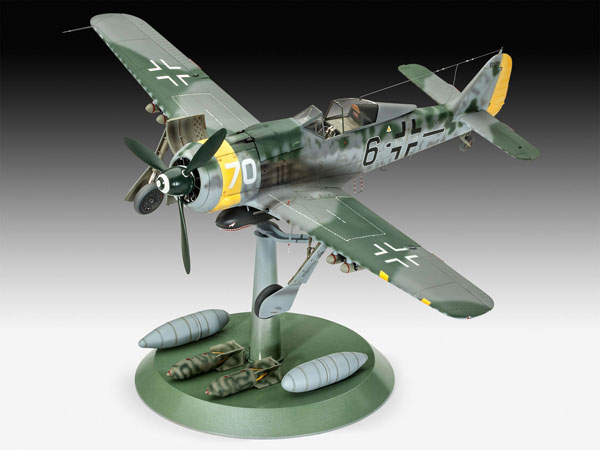
Kit Ref: 04869
Price around Price around £35.88 GBP, €39.99, $58.97AUS, $45.93USD, $58.67CAD (July 2017)
Review by Geoff Coughlin
Our thanks to Revell for supplying our review sample: Revell model kits are available from all good toy and model stores. For details visit www.revell.de/en

A little bit of background
The Focke-Wulf Fw 190 Würger (English: Shrike) was a German single-seat, single-engine fighter aircraft designed by Kurt Tank in the late 1930s and widely used during World War II. Along with its well-known counterpart, the Messerschmitt Bf 109, the Fw 190 became the backbone of the Luftwaffe’s Jagdwaffe (Fighter Force). The twin-row BMW 801 radial engine that powered most operational versions enabled the Fw 190 to lift larger loads than the Bf 109, allowing its use as a day fighter, fighter-bomber, ground-attack aircraft and, to a lesser degree, night fighter.
The Fw 190A started flying operationally over France in August 1941, and quickly proved superior in all but turn radius to the Royal Air Force’s main front-line fighter, the Spitfire Mk. V, especially at low and medium altitudes. The 190 maintained superiority over Allied fighters until the introduction of the improved Spitfire Mk. IX in July 1942. In November/December 1942, the Fw 190 made its air combat debut on the Eastern Front, finding much success in the specialised ground attack units called Schlachtgeschwader (Battle Wings or Strike Wings) from October 1943 onwards, following the re-designation of all former Sturzkampfgeschwader dive-bomber wings at that time.
Though Soviet pilots considered the Bf 109 the greater threat, the Fw 190 and its pilots proved just as capable as the “lean” (to VVS pilots) inverted V-12 inline-powered Messerschmitt in aerial combat. In the opinion of German pilots who flew both, the Fw 190 provided increased firepower and manoeuvrability at low to medium altitude. Still, it never entirely replaced the Bf 109.
The Fw 190A series’ performance decreased at high altitudes (usually 6,000 m (20,000 ft) and above), which reduced its effectiveness as a high-altitude interceptor, but this problem was mostly rectified in later models, particularly in the Junkers Jumo 213 inline-engine Focke-Wulf Fw 190D series, which was introduced in September 1944 and restored relative parity with Allied opponents.
The Fw 190 was well-liked by its pilots. Some of the Luftwaffe’s most successful fighter aces claimed a great many of their kills while flying it, including Otto Kittel, Walter Nowotny and Erich Rudorffer.
Fw 190 F-8
The A-8 model re-designated, having a slightly modified injector on the compressor which allowed for increased performance at lower altitudes for several minutes. Armament of the Fw 190 F-8 was two 20 mm MG 151/20 cannon in the wing roots and two 13 mm (.51 in) MG 131 machine guns above the engine.
Fw 190 F-8/U1 – long range JaBo, fitted with underwing V.Mtt-Schloß shackles to hold two 300 L (80 US gal) fuel tanks. ETC 503 bomb racks were also fitted, allowing the Fw 190 F-8/U1 to carry one SC 250 bomb under each wing and one SC 250 bomb on the centreline.
Fw 190 F-8/U2 – torpedo bomber was fitted with an ETC 503 bomb rack under each wing and a centre-line mounted ETC 504. The U2 was also equipped with the TSA 2 A weapons sighting system that improved the U2’s ability to attack seaborne targets with a 700 kg (1,500 lb) BT 700.
Fw 190 F-8/U3 – heavy torpedo bomber was outfitted with an ETC 502, which allowed it to carry one BT-1400 heavy torpedo (1,400 kg (3,100 lb)). Owing to the size of the torpedo, the U3’s tail gear needed to be lengthened. The U3 also was fitted with the 2,000 PS BMW 801S engine, and the tail from the Ta 152.
Fw 190 F-8/U4 – created as a night fighter, was equipped with flame dampers on the exhaust and various electrical systems such as the FuG 101 radio altimeter, the PKS 12 automatic pilot, and the TSA 2 A sighting system. Weapons fitted ranged from torpedoes to bombs; however, the U4 was fitted with only two MG 151/20 cannon as fixed armament.
